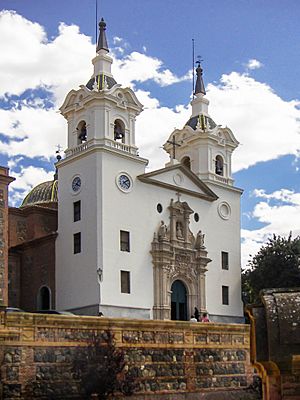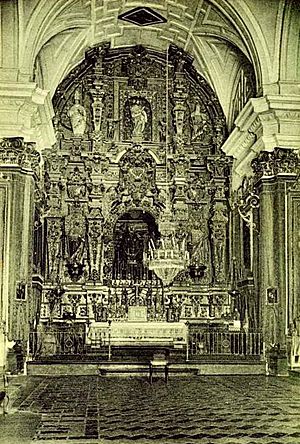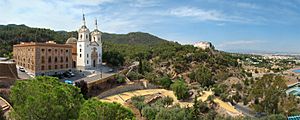Sanctuary of Our Lady of Fuensanta facts for kids
Quick facts for kids Sanctuary of Our Lady of Fuensanta |
|
|---|---|
|
Santuario de la Virgen de la Fuensanta
|
|

View of the sanctuary's facade
|
|
| Religion | |
| Affiliation | Roman Catholic Church |
| District | Diocese of Cartagena |
| Ecclesiastical or organizational status | National Monument |
| Location | |
| Location | Algezares, Murcia, Spain |
| Architecture | |
| Architectural type | Sanctuary |
| Architectural style | Baroque |
| Completed | 1705 |
The Sanctuary of Our Lady of the Holy Fountain (Spanish: Santuario de Nuestra Señora de la Fuensanta) is a beautiful church in the Baroque style. It belongs to the Roman Catholic Church. You can find it in the village of Algezares, which is part of the city of Murcia in Spain.
This special church is home to the statue of Our Lady of Fuensanta. She is considered the patron saint (a special protector) of Murcia and its nearby fertile farmlands, called the huerta. The statue is very important in religious parades, known as religious processions. These parades happen twice a year, in spring (during Lent) and in September, when the statue is carried to Murcia Cathedral.
Contents
The Holy Site
People in Murcia have shown great devotion to Our Lady of Fuensanta for a very long time. This tradition began because of a story about Mary appearing on a mountain called El Hondoyuelo. This mountain is about five kilometers from Murcia city. When she appeared, a holy spring (a special water source) called fuente santa (holy fountain) was said to have formed. This small spring still flows today.
Early Beginnings
According to old stories, a small religious building called a hermitage was built in a cave during the Middle Ages. Monks took care of it. Records show that this hermitage existed as far back as the year 1429.
By the late 1600s, the original hermitage was getting old and too small. More and more people wanted to visit it. It was described as being "between a church and a mosque". Plans to fix the old hermitage were made in 1624 and 1664, but they didn't happen. A bigger church was clearly needed.
Building History
In the late 1600s, there was a very bad drought (a long period with no rain). Many people went to Fuensanta to pray for rain. Because of this, the building you see today started to be built in 1694.
Construction and Design
The front part of the church, called the facade, was finished in 1705. It was designed by an architect named Toribio Martínez de la Vega. The facade also had beautiful carvings and statues. These were designed by Jaime Bort and finished by José Balaguer.
In 1925, Rafael Castillo Sáiz helped to fix the church's towers. Later, during the Spanish Civil War (a big conflict in Spain), the inside of the church was damaged. This happened in 1936. Because of the damage, the church had to be completely rebuilt in the middle of the 20th century. Today, the Diocese of Cartagena owns the shrine. It has been named a Cultural Heritage Site, which means it's a very important historical place.
Church Features
The church is built in the Baroque style. It has a main open space called a nave, with smaller chapels on the sides. There is also a large dome over the central part of the church.
Main Facade Details
The main front of the church, designed by Toribio Martínez de la Vega, has two tall towers. It also has a stone entrance. Above this entrance, you can see two angels holding the special symbol of the Murcia Cathedral Chapter (a group of priests). In the middle of the facade, there is a statue of Our Lady of Fuensanta. This statue was made by Jaime Bort. On either side of her are statues of Saint Fulgentius of Cartagena and Saint Patrick.
Inside the Sanctuary
Inside the church, the main altar was created by Antonio Carrión Valverde and Nicolás Prados López. This altar replaced the original Baroque one, which was destroyed in 1936. The statue of Our Lady of Fuensanta, whose artist is not known, is kept in a special small room called a camarín.
The dome and the choir (where singers stand) have beautiful paintings called murals. These were painted by Pedro Flores García. They show scenes of people going on pilgrimages (religious journeys) and the crowning of Our Lady of Fuensanta. In the side chapels, there are ten carved pictures. These show different moments from the life of the Virgin Mary. They were created by Juan González Moreno.
Beautiful Surroundings
The sanctuary is surrounded by many interesting historical and natural places. These include:
- The "Fuente Santa" (Holy Fountain), a fountain built in the Renaissance style, located down the hill.
- The House of the Cathedral Chapter, a building with a unique Neo-Arabic design, on a nearby hill.
- The Monastery of Benedictine Nuns, who help manage the shrine. This monastery is connected to the church by an arched walkway.
The Sanctuary of Fuensanta is located in the middle of the Cordillera Sur (Southern Mountain Range). It's in the village of Algezares, in a mountainous area next to the Segura River Valley to the south. From this spot, you can see amazing views of the countryside around Murcia. The church is also right next to the Carrascoy and El Valle Regional Park, which is a protected natural area.
This sanctuary is one of the most visited places in Spain. People come not only for religious reasons but also to enjoy its beautiful location. From its high spot on the hill, it offers the best views of Murcia and the Segura Valley.
See also
 In Spanish: Santuario de Nuestra Señora de la Fuensanta (Murcia) para niños
In Spanish: Santuario de Nuestra Señora de la Fuensanta (Murcia) para niños



